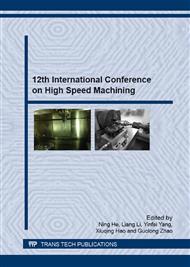p.3
p.13
p.20
p.29
p.36
p.43
p.48
p.56
Experimental Investigations into Machining of FRP Material
Abstract:
Machining of fibre-reinforced thermosets is becoming a very popular technology today. Nevertheless, machinability of these materials is rather different from conventional materials such as metals since hard and abrasive fibres are combined with relatively soft resin with low glass transition temperature. Special attention has to be given to workpiece quality because delamination and burning of machined surface can occur. An experimental investigation into machinability of a polymeric and cellulose fibre-reinforced resin material was carried out. Milling operations were inspected with respect to process temperature, cutting forces and machined surface quality. The effect of cutting conditions on the mentioned aspects was determined. Standard and tailored cutting tools were used in the investigation. It was observed that surface quality is strongly dependent on tool geometry, milling strategy, fibre orientation and feed. On the other hand, cutting forces are relatively low and dependent on tool geometry and feed. The modified cutting tool with more positive tool geometry showed better results compared to the conventional one.
Info:
Periodical:
Pages:
29-35
Citation:
Online since:
January 2016
Authors:
Keywords:
Price:
Сopyright:
© 2016 Trans Tech Publications Ltd. All Rights Reserved
Share:
Citation:


